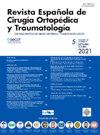Arthroscopic fibroarthrolysis and mobilization under anesthesia is a simple, reproducible, and satisfactory method for the treatment of patients with severe post-traumatic arthrofibrosis of the knee
Q3 Medicine
Revista Espanola de Cirugia Ortopedica y Traumatologia
Pub Date : 2025-05-01
DOI:10.1016/j.recot.2024.07.008
引用次数: 0
Abstract
Objective
To evaluate the range of motion (ROM) of the knee in patients with severe post-traumatic knee arthrofibrosis after being treated with arthroscopic fibroarthrolysis (AFA) and manipulation under anesthesia (MUA).
Methods
Case series of patients with severe post-traumatic knee arthrofibrosis who underwent AFL + MUA in a national referral center. The primary outcome to be assessed was ROM before and after surgery and then at 3-month intervals until a minimum follow-up of one year was completed.
Results
51 patients were included. The main injuries preceding the stiffness were tibial plateau fracture (37.3%), distal femur fracture (27.5%), and femoral shaft fracture (15.7%). Forty-five patients had severe flexion deficits with a median preoperative flexion of 70°. Intraoperative flexion significantly improved to 110°. Significant loss of flexion was observed at 3 and 6 months, however, patients regained ROM in the 9 and 12-month follow-ups. At discharge, 80% of the patients achieved flexion of 90° or more. There were 4 intraoperative complications and 3 reinterventions were performed.
Conclusion
AFA + MUA can help patients with severe post-traumatic knee arthrofibrosis to recover ROM in most cases. However, this procedure is not without risks and complications, therefore, careful consideration should be given to its indication and execution.
关节镜下纤维关节松解术和麻醉下活动术是治疗严重创伤后膝关节纤维化患者的一种简单、可重复和令人满意的方法。
目的评估严重创伤后膝关节纤维化患者在接受关节镜下纤维关节松解术(AFA)和麻醉下手法治疗(MUA)后的膝关节活动范围(ROM):方法:在一家国家转诊中心接受关节镜下纤维关节松解术(AFA)和麻醉下手法(MUA)治疗的严重创伤后膝关节软化症患者的病例系列。评估的主要结果是手术前后的ROM,然后每隔3个月进行一次评估,直至完成至少一年的随访:结果:共纳入 51 名患者。造成僵硬的主要损伤是胫骨平台骨折(37.3%)、股骨远端骨折(27.5%)和股骨干骨折(15.7%)。45名患者有严重的屈曲障碍,术前中位屈曲度为70º。术中屈曲明显改善,达到 110º。术后3个月和6个月,患者的屈曲功能明显减弱,但在9个月和12个月的随访中,患者的屈曲功能得到恢复。出院时,80%的患者屈曲度达到或超过90º。术中出现了4例并发症,进行了3次再干预:结论:AFA+MUA在大多数情况下可以帮助严重创伤后膝关节软化症患者恢复膝关节活动度。结论:AFA + MUA 可以帮助大多数严重创伤后膝关节软化症患者恢复 ROM,但这种手术并非没有风险和并发症,因此在适应症和实施方面应慎重考虑。
本文章由计算机程序翻译,如有差异,请以英文原文为准。
求助全文
约1分钟内获得全文
求助全文
来源期刊

Revista Espanola de Cirugia Ortopedica y Traumatologia
Medicine-Surgery
CiteScore
1.10
自引率
0.00%
发文量
156
审稿时长
51 weeks
期刊介绍:
Es una magnífica revista para acceder a los mejores artículos de investigación en la especialidad y los casos clínicos de mayor interés. Además, es la Publicación Oficial de la Sociedad, y está incluida en prestigiosos índices de referencia en medicina.
 求助内容:
求助内容: 应助结果提醒方式:
应助结果提醒方式:


